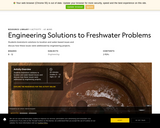
Students brainstorm solutions to location and water-based issues and discuss how these issues were addressed by engineering projects.
- Provider:
- National Geographic
- Author:
- Molly Emmett
- Date Added:
- 06/24/2019

Students brainstorm solutions to location and water-based issues and discuss how these issues were addressed by engineering projects.

This guide was developed to support teachers in teaching topics with real-world context, and provide them with the background to feel competent and comfortable when teaching about fresh water. The guide includes numerous education features, such as teaching tips and student thinking, that help to connect the content to classroom practice.

In this activity students will learn about the many factors, both man-made and natural, that affect fish populations in the estuary. By learning how humans have a negative influence on estuarine fish populations, students will learn how to become better stewards of the environment.

In this lesson, students will take on the role of a member of an environmental club and will search the database to find a wetland that they would be interested in helping to protect. Using the database search capabilities, they will first select various wetland characteristics and generate a report on the sites that meet their search criteria. Next, they will access an interactive map to view the locations and nearby features of the identified wetland sites. They will then narrow the choices down to a single wetland that they would like to protect and gather further information about it. Finally, as a member of the club, they will prepare a brief report to persuade others of the value of protecting their chosen site.

In this two-day lesson, students will be introduced to several water sustainability issues, including access to clean freshwater, groundwater depletion, agricultural water use, and water waste.
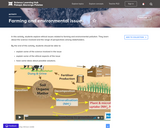
Students explore ethical issues related to farming and environmental pollution. They learn about the science involved and the range of perspectives among stakeholders.
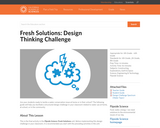
In this lesson, students will work collboratively to tackle a water conservation issue at home or in their school.
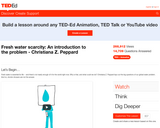
This brief video lesson discusses the global water problem of scarcity. Discussion/assessment questions and suggested supplemental resources are also included.

In this lesson, students participate in a kinesthetic simulation to illustrate how nutrient pollution from agricultural runoff can lead to a dead zone at the mouth of a drainage basin.
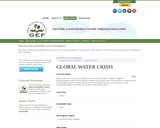
Students will research water crisis conditions for one of the following countries: Bangladesh, Ethiopia, Honduras, India, or Kenya and then report their findings to the class.

This lesson plan specifically addresses the implications of a natural disaster and its effects on water quality and a community's health. Students will learn methods used during an emergency response to test and treat water that has been contaminated by pathogenic microorganisms. Water treatment options introduced can vary depending on the location and type of emergency involved, but have the same goal to reduce human illness and death. After completing this lesson, students will have an improved understanding of which organizations are involved in emergency response and why safe drinking water is a substantial heath concern after a natural disaster.

During this unit, students will learn about the Great Pacific Garbage Patch. They will read about the GPGP and then prepare a presentation with their findings and solutions. Lastly, they will create a prototype to help with the ocean cleanup and use Spheros to maneuver the prototype to pick up trash in water.
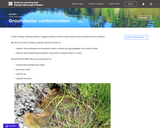
Students build an aquifer model to look at point source and non-point source pollution.

This resource explains the causes and effects of major oil spills and the role that ocean currents play in the spread of pollution.
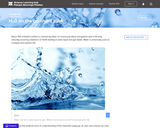
In this unit, students develop an appreciation of the global, dynamic, and complex nature of the water cycle and explain how human activities can impact the functioning of the water cycle.

In this activity, students will interpret how biological indicators are used to gauge the health of a stream and practice calculating the biotic index of a simulated stream site in order to analyze the water quality.

This video explores key water issues, the water cycle, and some of the technology and techniques used to conserve water. A set of discussion questions and post-viewing activities are provided.
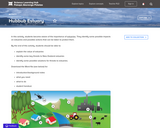
Students become aware of the importance of estuaries. They identify some possible impacts on estuaries and possible actions that can be taken to protect them.
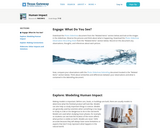
In this activity, students use a model to better understand the impact that humans might have on water supplies.

Students use a variety of media to discuss and analyze human-related pressures upon marine ecosystems and resources.